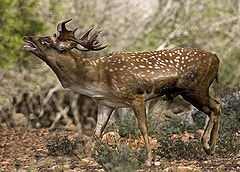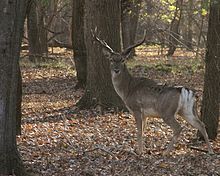- Persian fallow deer
-
Persian Fallow Deer 
Conservation status Scientific classification Kingdom: Animalia Phylum: Chordata Class: Mammalia Order: Artiodactyla Family: Cervidae Subfamily: Cervinae Genus: Dama Species: D. dama Subspecies: D. d. mesopotamica Trinomial name Dama dama mesopotamica
(Brooke, 1875)The Persian Fallow Deer (Dama dama mesopotamica) is a rare ruminant mammal belonging to the family Cervidae. Its taxonomic status is disputed, with some maintaining it as a subspecies of the Fallow Deer,[2] while other treat it as a separate species, Dama mesopotamica.[1]
Contents
Description
Persian fallow deer are bigger than Fallow Deer, their antlers bigger and less palmated. They are nearly extinct today, inhabiting only a small habitat in Khuzestan, southern Iran, two rather small protected areas in Mazandaran (northern Iran), an area of northern Israel and an island in Lake Urmia in north-western Iran and in some parts of Iraq.[3][unreliable source?] They were formerly found from Mesopotamia and Egypt to the Cyrenaica and Cyprus. Their preferred habitat is open woodland. They are bred in zoos and parks in Iran, Israel and Germany today. The existing population may be suffering from inbreeding and lack of genetic diversity. Since 1996 they have been gradually and successfully reintroduced from a breeding center in the Carmel, into the wild in northern Israel, and more than 650 of them now live in the Galilee, Mount Carmel areas and the Brook of Sorek.[4]
History
Persian Fallow Deer were introduced to Cyprus in the pre-pottery Neolithic (Cypro-PPNB), if not earlier. They occur in significant numbers at the aceramic Neolithic sites of Khirokitia, Kalavasos-Tenta, Cap Andreas Kastros, and Ais Yiorkis, and were important through the Cypriot Bronze Age. A Greek legend, related by Aelianus ca 200 AD, recounts how the deer of the Lebanon and Mount Carmel reached Cyprus by swimming the Mediterranean, the head of each animal placed on the back of the deer in front of it.
Deer from Epirus in Greece are said to have reached Corfu in the same manner. While Red Deer are known to cross open water in their seasonal migrations, for example on the Scottish islands, this behaviour is unknown in Fallow Deer. Persian Fallow Deer had been considered extinct in 1951, before a small population was discovered in Khuzestan.
References
- ^ a b Rabiei, A. (2008). Dama mesopotamica. In: IUCN 2008. IUCN Red List of Threatened Species. Downloaded on 8 April 2009. Database entry includes a brief justification of why this species is of endangered.
- ^ Wilson, Don E.; Reeder, DeeAnn M., eds (2005). Mammal Species of the World (3rd ed.). Baltimore: Johns Hopkins University Press, 2 vols. (2142 pp.). ISBN 978-0-8018-8221-0. OCLC 62265494. http://www.bucknell.edu/msw3/browse.asp?id=14200388.
- ^ http://www.nationsencyclopedia.com/Asia-and-Oceania/Iraq-ENVIRONMENT.html
- ^ Israel's rescued deer - In 1978, Israel rescued four Persian fallow deer from Iran. It has been protecting descendants of the rare and once free-roaming species ever since.; Feb 10 2010; Mother Nature Network (MNN)
External links
- Persian fallow deer at Animal Info
Categories:- IUCN Red List endangered species
- Cervines
- Mammals of Asia
- Fauna of Iran
Wikimedia Foundation. 2010.


